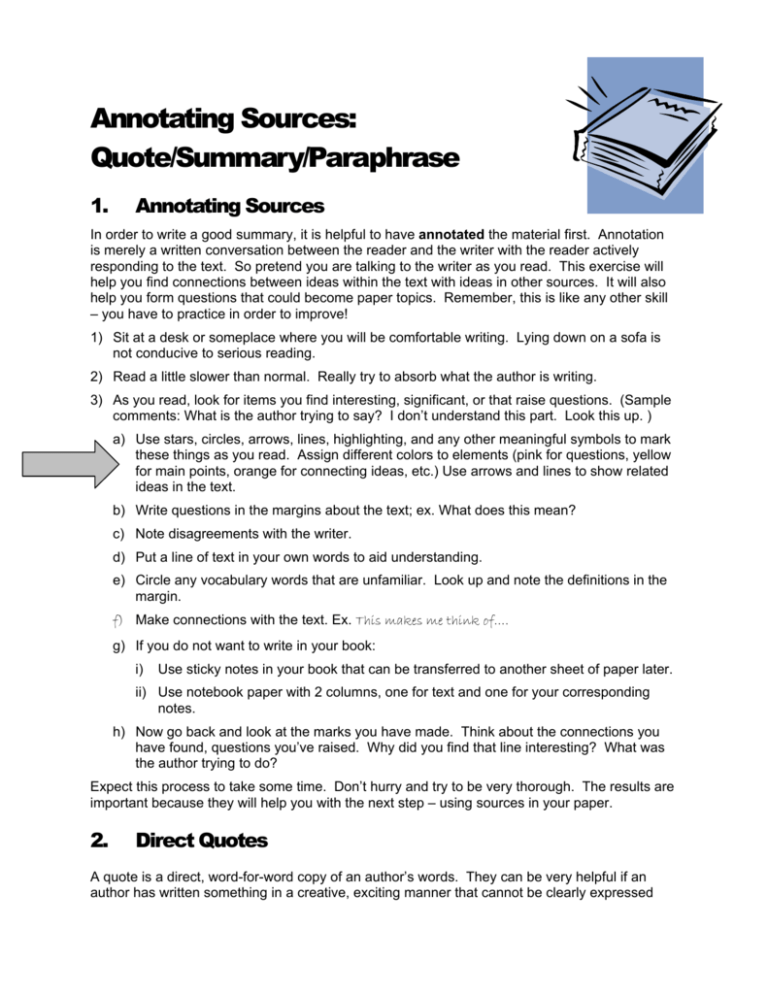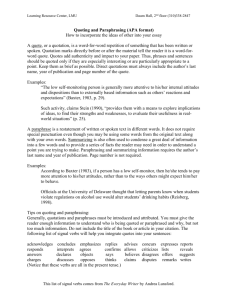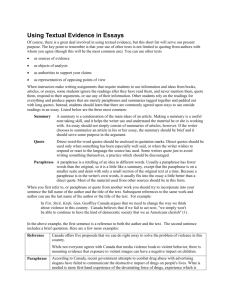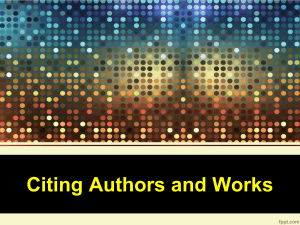
Annotating Sources:
Quote/Summary/Paraphrase
1.
Annotating Sources
In order to write a good summary, it is helpful to have annotated the material first. Annotation
is merely a written conversation between the reader and the writer with the reader actively
responding to the text. So pretend you are talking to the writer as you read. This exercise will
help you find connections between ideas within the text with ideas in other sources. It will also
help you form questions that could become paper topics. Remember, this is like any other skill
– you have to practice in order to improve!
1) Sit at a desk or someplace where you will be comfortable writing. Lying down on a sofa is
not conducive to serious reading.
2) Read a little slower than normal. Really try to absorb what the author is writing.
3) As you read, look for items you find interesting, significant, or that raise questions. (Sample
comments: What is the author trying to say? I don’t understand this part. Look this up. )
a) Use stars, circles, arrows, lines, highlighting, and any other meaningful symbols to mark
these things as you read. Assign different colors to elements (pink for questions, yellow
for main points, orange for connecting ideas, etc.) Use arrows and lines to show related
ideas in the text.
b) Write questions in the margins about the text; ex. What does this mean?
c) Note disagreements with the writer.
d) Put a line of text in your own words to aid understanding.
e) Circle any vocabulary words that are unfamiliar. Look up and note the definitions in the
margin.
f) Make connections with the text. Ex. This makes me think of….
g) If you do not want to write in your book:
i)
Use sticky notes in your book that can be transferred to another sheet of paper later.
ii) Use notebook paper with 2 columns, one for text and one for your corresponding
notes.
h) Now go back and look at the marks you have made. Think about the connections you
have found, questions you’ve raised. Why did you find that line interesting? What was
the author trying to do?
Expect this process to take some time. Don’t hurry and try to be very thorough. The results are
important because they will help you with the next step – using sources in your paper.
2.
Direct Quotes
A quote is a direct, word-for-word copy of an author’s words. They can be very helpful if an
author has written something in a creative, exciting manner that cannot be clearly expressed
any other way. Quotes are helpful tools in that they can increase your credibility depending on
your source.
However, it is important to remember that your paper is about what you have to say. Too many
quotes will take away from your ideas. Remember, sources are supposed to support your
arguments. They are evidence. If you find yourself quoting every source, you may want to
consider changing some to paraphrases or summaries (see following sections.)
•
When quoting, copy the exact wording and punctuation.
•
Enclose the quote in quotation marks (“
•
If you need to make a small change, enclose the change in brackets ([ ]).
•
Use ellipsis if you omit material (. . .).
•
Always introduce or “frame” a quote. Without an introduction, the reader isn’t
clear on what to make of the quote or why the person being quoted is important.
•
Always include parenthetical citation. You do not want to plagiarize!
“).
Examples:
According to Jim Jones, author of Creative Psychology, “Character[s] of this type will not…”
(12).
The last name is not included in the citation because
it was already cited at the beginning of the sentence.
According to a recent study conducted by Michigan State etymologists, “The Brazilian house fly
is not related to the Panamanian house fly” (Smith and Stone 423).
The citation is not included in
quotation marks. The period comes
after the citation.
For additional information on punctuation and citation, refer to your grammar and usage
handbook. Look up “quotations” in the index.
3.
Writing a Summary
Summarizing can be a continuation of your conversation with the writer. In effect, you are
repeating his/her main ideas in your own words. This is not a word-for-word copy of the
author’s essay (see the section on paraphrasing). Remember to focus on the main ideas. First,
answer two questions: 1) What is the subject of the writing? 2) What is the central message on
the subject and/or the main idea?
Next, realize that when you write a summary, you will be reducing the original text by at least
half. So as you summarize, you will trace the writer’s train of thought by using the subject, main
idea and then the supporting details in your summary. Be careful not to interpret the writer’s
ideas, just report them. (You may want to put your interpretations in the margin for future
reference.) Also, do not PLAGIARIZE! Be sure to document the source you are summarizing.
In short here are some tips to follow:
1) Read the text carefully looking for the main idea, supporting details, condensing them
without losing the writer’s main intent.
2) Write a sentence that gives the main idea using your own words.
3) Next, write a few sentences that give the supporting details being careful to use your own
words.
4) Now, put all the sentences together using transition words (Writer’s Handbook 84) and good
verbs (Writer’s Handbook 500).
5) Finally, cite your summary and double check for plagiarism.
a. Remember, changing one or two words does not constitute using your own
words. Copying the sentence structure is too close to quoting to be
academically honest. If you put something in your own words, change the
whole thing!
b. Always introduce or “frame” a summary. Without an introduction, the reader
isn’t clear on what to make of the quote or why the person being quoted is
important.
c. Example: To summarize Bernstein’s article on astrophysics,…..
MORE TIPS:
•
Make a graphic organizer of the main idea and the supporting details as you read. Use
a web, or any sort of organizer that is meaningful to you.
•
Remember that a summary = main idea + some supporting details.
•
A summary does NOT include any of your ideas.
•
If you use the writer’s key words or phrases, be sure to quote and document them.
•
Make sure you have indicated the author’s meaning of the writing in your summary.
4.
Paraphrasing
A paraphrase “accurately states all the relevant information from a passage in your own words
and phrasing, without any additional comments or elaboration” (Little, Brown 488).
Paraphrasing is useful when the information from a particular source is helpful, but the wording
is not. Since paraphrasing requires thought and attention to detail, it shows the reader you
understand the source.
When paraphrasing DO:
•
Use all of your own words and sentence structure.
•
Restate all the main points in order.
•
Introduce/frame the paraphrase.
•
Cite your source!
DO NOT:
•
Use the author’s words or phrasing.
•
Use the author’s sentence structure.
•
Include your own comments.
Check this
out!
For additional help:
Fowler, H. Ramsey and Jane. E. Aaron. The Little, Brown Handbook. Ninth ed. New York:
Pearson Longman, 2004.
Handbook for Writers. Custom edition for Blinn College. Boston: Pearson, 2002.








